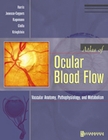Harris et al: ATLAS OF OCULAR BLOOD FLOW: Vascular Anatomy,
Physiology and Pathophysiology TABLE OF CONTENTS: I. Ocular
vasculature, anatomical structure and function 1. Anatomy
(different illustrations on anatomical structures in the orbit)
a. Description of vasculature (and anatomic variations)
beginning from the heart to the ophthalmic vein b. Innervation
2. Vascular physiology: Controls in general terms a. Innervation
b. Autoregulation (e.g., intracular pressure) c. Relationship
between blood pressure and blood flow in these vessels d.
Intraocular pressure and blood flow to these vessels e.
Different influencing factors (e.g. mediators of vessel
dilation, vasoconstrictors) with diagrams showing affection of
vessels 3. Pathophysiology a. Loss of innervation (Horner
syndrome) b. Ion channel dysfunction (theory) c. Vasospasm
(clinical observation, cold hand, migraine, raynaud) d. Gas
perturbations (hyperoxia, hypoxia, hypercapnia) and pharmacology
II. Principles of technology (including diagrams) 4. Ultrasound
a. Physical basics and anatomical description with illustrations
b. History/early measurements c. Contemporary measurements d.
Clinical examples 5. Angiography a. Physical basics and
anatomical description b. History/early measurements c.
Contemporary measurements d. Clinical 6. Laser Doppler
technologies a. Physical basics and amatomical description b.
History/early measurements c. Comtemporary measurements d.
Clinical examples 7. Pulsatility based techniques a. Physical
basics and anatomical description b. History/early measurements
c. Contemporary measurements d. Clinical examples III. Principal
applicability to diseases (examples of altered circulation) 8.
Glaucoma (visual acuity, contrast sensitivity, visual fields,
blood flow) a. POAG b. NTG c. CACG d. Other; one image per
subdivision 9. Age-related macular degeneration a. One photo per
stage, beginning with pigment shift, ending with subretinal
meovascularization 10. Diabetic retinopathy 11. Arteriitic and
non-arteriitic ischemic neuropathy 12. Vascular occlusions a.
Arterial occulusion b. Vein occlusion c. Partial vessel
occlusion (one-vessel-branch) d. Remaining macular vessel 13.
Infections a. Histoplasmosis b. CMV c. Toxoplasmosis d. Any
other infection related to blood flow disorders 14. Degenerative
diseases a. Retinitis pigmentosa b. Any other disease related to
vascular disorders (eg, vaskulitis) IV. New techniques and their
future application BOOKS OF RELATED INTEREST: Kaufman: Adler's
Physiology of the Eye, 10/e; 2002; ISBN: 0-323-01136-5 Byrne:
The Ultrasound of the Eye & Orbit, 2/e; 2002; ISBN: 0-323-01207-
8 Burde: Clinical Decisions in Neuro-Ophthalmology,3/e; 2002;
ISBN: 0-323-01707-X
Author Information
By Alon Harris, MSc, PhD, Professor of Ophthalmology, Professor
of Physiology and Biophysics, and holder of the Letzter Endowed
Chair; Co-Director of Age-Related Macular Degeneration Clinical
& Research Center; Director of Glaucoma Research and Diagnostic
Center, Department of Ophthalmology; Indiana University School
of Medicine, Indianapolis, IN; Christian P. Jonescu-Cuypers, MD,
PhD, Department of Ophthalmology, University Eye Hospital of
Cologne, Cologne, Germany; Ophthalmologist and Head of
Laboratory of Biomorphometry and Retinal Perfusion Analysis
Cologne; Assistant Director Medical Imaging, Glaucoma Research
and Diagnostic Center, Indiana University School of Medicine,
Indianapolis, IN; Larry Kagemann, MS, BME, Biomedical Research
Engineer and Assistant Director, Glaucoma Research and
Diagnostics Center, Department of Ophthalmology, Indiana
University School of Medicine, Indianapolis, IN; Thomas A.
Ciulla, MD, Co-Director, Retina Service, Associate Professor of
Opthalmology, Indiana University School of Medicine,
Indianapolis, IN; and G?ter K. Krieglstein, MD, PhD, Professor
of Ophthalmology, Director and Chairman


